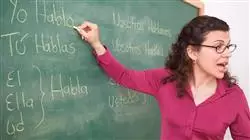University certificate
The world's largest faculty of education”
Introduction to the Program
Acquires the specific skills necessary to teach Spanish to students from immigrant backgrounds, adapting it to their special circumstances"

Any attempt at communication requires the speaker to have a complete command of their communicative abilities. In the case of immigrant minors, this command becomes extremely necessary because it is the key to access the new life in which children and young people are immersed. That is why this Postgraduate diploma is based on knowledge of linguistic, sociolinguistic and pragmatic skills. To teach Spanish as a foreign language, it is essential to know all the skills that students must develop and their different learning stages, in order to develop different methodologies adapted to their educational needs.
Over the next few months, the teachers will be shown how to manage the learning of the child or adolescent, looking at the characteristics of the methodology, behavioral patterns and even the acculturation processes to which immigrants are exposed.
In addition, this Postgraduate diploma will provide teachers with the necessary tools and knowledge to practice the profession with confidence and efficiency, enabling them to help immigrant children and adolescents to understand and analyze messages effectively, and to develop non-verbal communication.
The teacher will be able to explain and resolve confusing grammar issues or questions regarding their student’s assessment process. Students will have a complete vocabulary teaching methodology and different techniques and didactic materials, taught by distinguished experts in the field with extensive experience in the educational sector.
All of this, taking into consideration that teaching is a discipline that must advance at the same pace as technological advances. For that reason, this program has been designed for the teacher to be trained with the latest educational technology to discover every aspect of digital learning.
This program will allow students to develop and expand their knowledge and skills related to Spanish lexical competence in teaching. At the end of the Postgraduate diploma, you will be able to detect common errors in Spanish teaching and will have acquired the necessary tools to prevent and correct them, so that you have the skills to work as a teacher of Spanish as a foreign language.
With an educational approach based on the resolution of real situations, this Postgraduate diploma will allow you to apply what you have learned in your daily teaching practice, immediately and with total confidence"
This Postgraduate diploma in Teaching Spanish as a Foreign Language for Immigrant Children and Adolescents contains the most complete and up-to-date educational program on the market. The most important features include:
- The latest technology in online teaching software
- Intensely visual teaching system, supported by graphic and schematic contents, easy to assimilate and understand
- Practical cases presented by practising experts
- State-of-the-art interactive video systems
- Teaching supported by telepractice
- Continuous updating and recycling systems
- Autonomous learning: full compatibility with other occupations
- Practical exercises for self-evaluation and learning verification
- Support groups and educational synergies: questions to the expert, debate and knowledge forums
- Communication with the teacher and individual reflection work
- Content that is available from any fixed or portable device with an Internet connection
- Complementary documentation databases are permanently available, even after the program
This program has been meticulously designed by active experts who will provide you with a realistic and contextual vision of this subject”
The teaching staff includes teaching professionals, who bring their experience to this training program, as well as renowned specialists belonging to leading societies and prestigious universities.
Its multimedia content developed with the latest educational technology, will allow the professional a situated and contextual learning, that is, a simulated environment that will provide an immersive learning programmed to train in real situations.
This program is designed around Problem-Based Learning, whereby the educator must try to solve the different professional practice situations that arise throughout the program. For this purpose, the professional will be assisted by an innovative interactive video system developed by recognized experts in the field of teaching.
Thanks to the e-learning methodology on which this Postgraduate diploma is based, you will learn different teaching approaches that will allow you to assimilate the knowledge in a dynamic and effective way"

Throughout these months you will study through practical and real cases that will help you to face complex situations in your daily teaching practice"
Syllabus
The contents of this Postgraduate diploma have been developed with a clear purpose: to ensure that our students acquire each and every one of the skills necessary to become true specialists in the teaching of Spanish, with the specific tools for teaching students from other cultures, in a situation of immigration. A complete and well-structured program that will take you to the highest standards of quality and success.

A broad and complete syllabus that will allow you to acquire new skills that will give your teaching practice the quality and security you need"
Module 1. Fundamentals of the Teaching Language
1.1. Teaching Language and Literature
1.1.1. Introduction to the Concept of Teaching
1.1.2. Teaching Language
1.1.2.1. Teaching Literature
1.1.2.2. Teaching from a Cultural Perspective
1.2. The Language and Literature Syllabus
1.2.1. Definition of the Concept of a Syllabus
1.2.2. The Elements and Parts of the Syllabus
1.2.3. The Syllabus of Language and Literature in Primary Education. Primary
1.2.4. The Language and Literature Syllabus in High School Education
1.3. Oral Language Didactics
1.3.1. Elements of Oral Proficiency
1.3.1.1. Characteristics of Oral Language
1.3.1.2. Teaching Oral Communication
1.3.1.3. Teaching Proposals
1.4. Teaching Written Language
1.4.1. Definition of the Concept of Written Language
1.4.2. Key Elements in Teaching Written Language
1.4.3. ICT in Teaching Language
1.4.3.1. Written Language Evaluation
1.5. Teaching Reading
1.5.1. Analysis of the Concept of Teaching Reading
1.5.1.1. Development and Characteristics of the Reading Process in Primary Education
1.5.1.2. The Promotion of Reading in the Educational Stage
1.5.1.3. Practical Applications of Teaching Reading
1.6. Teaching Literature
1.6.1. Definition of Teaching Literature
1.6.2. Elements of the Teaching Literature
1.6.3. Literature Teaching Methodologies
1.6.4. Evaluation of Literary Education
1.7. Practical Applications Didactic Programming
1.7.1. Definition of Educational Programming
1.7.1.1. Elements of Educational Programming
1.7.1.2. Development of a Program for Spanish Language and Literature
Module 2. Intercultural Communicative Competence and Mediation in the Spanish as a Foreign Language Classroom
2.1. The Adaptation of Material: Determinant Factors in Writing Spanish as L2
2.1.1. Writing and the Cognitive Process
2.1.2. Reflecting on Basic Matters
2.2. Types of Paradigm and Classification in Relation to the Key Elements of Teaching
2.2.1. Behaviorism
2.2.2. Mentalism
2.2.3. Model of the Monitor
2.2.4. Constructivism
2.3. Choice of Paradigms According to Context
2.3.1. The Influence of Context in the Application of Teaching and Learning Paradigm
2.4. Using Metaphors to Explain Concepts
2.4.1. Comparing Metaphors with Other Literary Resources
2.4.2. Metaphors for Students
2.5. The Conditioning Factors of Metaphors
2.5.1. How Does a Metaphor Mark the Knowledge of a Task/Learning?
2.6. Gender Patterns in Teaching: Increase of the Female Figure in the Spanish as a Second Language Classroom
2.6.1. Influence of the Female Figure in the Historical Teaching Framework
2.6.2. Commitment to Gender Impartiality in Schools
2.7. Values and Social Commitment to Education
2.7.1. Society and the Values Attributed to Teachers
2.8. Strategic Communication as a Means of Understanding the Educational Environment
2.8.1. Strategies Focused on How to Communicate
2.8.2. The School Environment as a Whole
2.9. Difference Between Translation and Mediation
2.9.1. Literal Translation/Interpreted Translation
2.9.2. Ways of Mediating to Understand the Content
2.9.3. Translation as a Means of Content Reduction or Augmentation
2.10. Facilitation of Mediations in Different Educational Environments
2.10.1. Tools for Facilitation
2.11. The Relationship Between the Language-Culture Binomial: Producing Material in Relation to Culture
2.11.1. Valuation of Mediation by Members of Foreign Cultures
2.12. Adapting Syllabus Material to the Cultural Environment
2.12.1. Educational Programming Around Cultural Diversity
2.12.2. Syllabus Richness in a Multicultural Class
Module 3. Teaching Spanish as a Foreign Language to Immigrant Children and Adolescents
3.1. Approach and Activities of Syllabus Adaptation
3.1.1. Types of Approach by Adaptation
3.1.1.1. How to Adapt the Syllabus Without Affecting the Variation of Basic Competencies?
3.2. Content Validation in Syllabus Adaptation
3.2.1. Validation for Improving
3.2.2. Close Relationship Between Validation and Social Support
3.3. Educative Models Adapted to the Mother Tongue
3.3.1. Psycholinguistics
3.4. Creating Material to Motivate Children and Adolescents in the Spanish as a Second Language Classroom
3.4.1. New Trends of Social and Personal Interest for Children and Adolescents
3.4.2. Apply Traditional Motivational Techniques
3.4.3. Comparing the Results of using Both Techniques
3.5. Development of Language Skills in Relation to Multiculturalism in the Classroom
3.5.1. Language from Different Points of View
3.5.2. The Value of Differences in Learning Skills
3.6. Dealing with Conflicts in the Classroom: Intercultural Particularities
3.6.1. Interviews, Assemblies and Mediations
3.7. Rules and Routines in the Classroom. Patterns of Behavior
3.7.1. Routine for Solving Conflicts
3.7.1.1. Communication and Negotiation Abilities
3.8. Self-Evaluation and Evaluating Peers
3.8.1. The Student as Protagonist
3.8.2. Realistic Guidance
3.9. Social Identity. Self-Concept and Acculturation
3.9.1. Developmental Stages in the Learning of a Target Language
3.9.2. Interlanguage and Social-Affective Resistance
3.10. Emotional Intelligence and Empathy
3.10.1. Approach to the Theory of Feelings
3.10.2. Empathizing Process: Development and Consolidation
3.11. Evaluating the Integrating Content
3.11.1. To What Extent Does Change Favor the Integration of Individuals to the Whole?
3.12. Overview of Diversity: The Influence of Multiculturalism on the Creation of Material
3.12.1. Guidelines for Monitoring Congruence in the Overall Vision
3.12.2. Diversity as a Means of Developing an Overall Vision
3.13. Reception and Production
3.13.1. Classroom Productivity Tools
3.14. Creating Content for Heterogenic Groups
3.14.1. Differences Between Group Members and Their Particular Contributions
3.14.2. Positive Interdependence
3.14.3. Simultaneous Face-to-Face Interaction
3.14.4. Cooperative Learning Dynamics

This will provide key training to advance your career"
Postgraduate Diploma in ELE Didactics for Immigrant Children and Adolescents
The didactics of ELE (Spanish as a foreign language) for immigrant children and adolescents refers to the set of techniques, approaches and strategies used to teach Spanish to students who have Spanish as a second language and who come from other countries.
ELE didactics for immigrant children and adolescents focuses on creating an inclusive learning environment that takes into account the linguistic and cultural needs of students and promotes the development of communication skills, literacy and intercultural competence.
Pedagogical strategies for ELE didactics for immigrant children and adolescents.
The communicative approach: this approach focuses on the practical use of Spanish as a means to communicate. Students learn to express themselves in everyday situations and acquire oral and written comprehension skills.
Social and cultural interaction: the aim is to create a learning environment where Spanish language and culture are integrated, allowing for better integration of immigrant students into the local community.
Formative evaluation: focuses on continuous evaluation of the learning process to provide immediate feedback to students and teachers.
The use of authentic materials and resources: it seeks to maintain a contextualized and authentic learning environment that incorporates Spanish culture and society.
ELE didactics for immigrant children and adolescents is dedicated to the teaching of Spanish as a foreign language, adapting to the needs and abilities of students who have Spanish as a second language so that they can acquire confidence and communicative and linguistic competence in an inclusive and intercultural environment.
Upon completion of this academic program, the Postgraduate Diploma in ELE Didactics for Immigrant Children and Adolescents will be prepared to teach Spanish as a foreign language to immigrant children and adolescents effectively, taking into account the cultural and linguistic particularities of their students.







